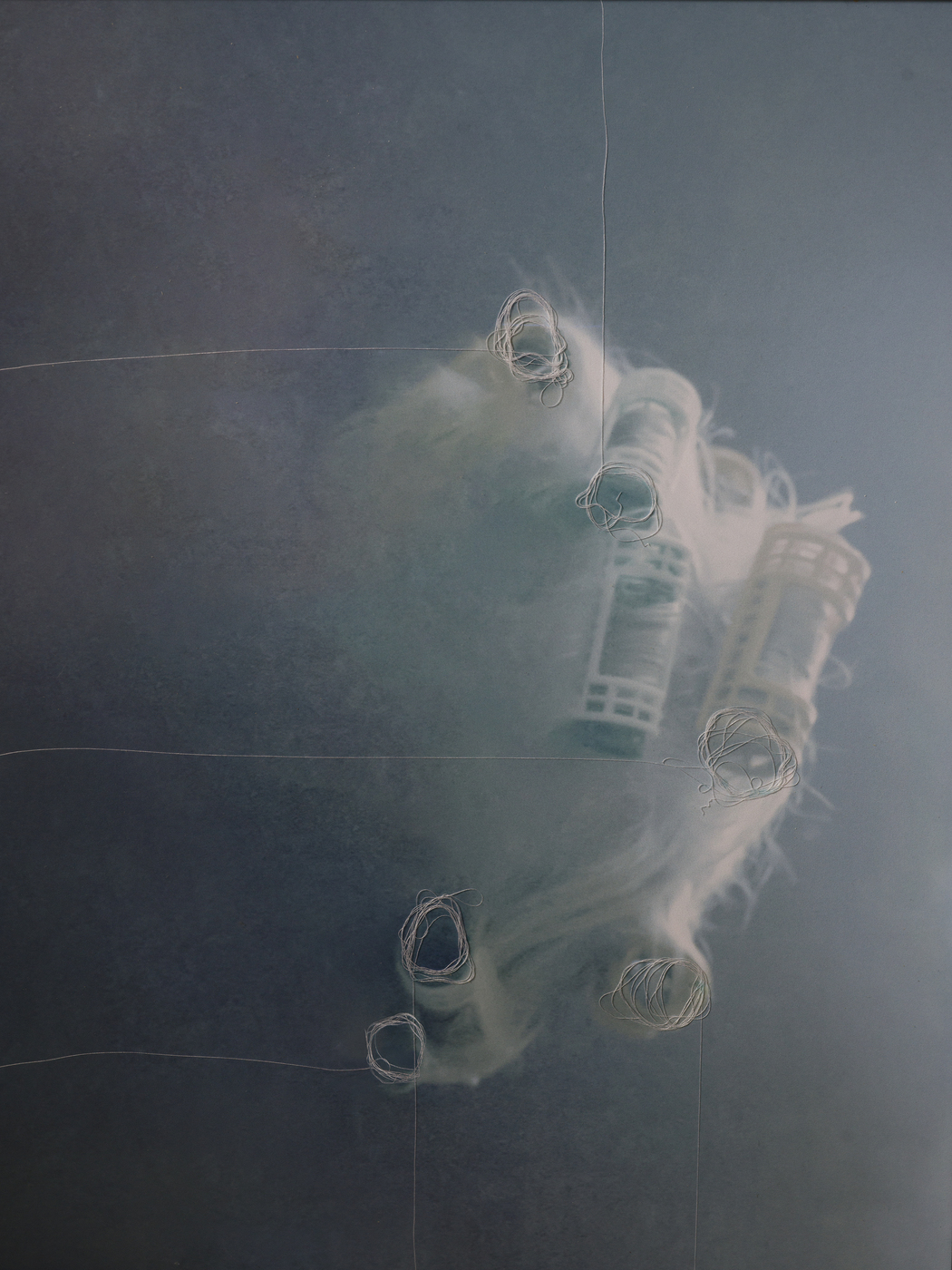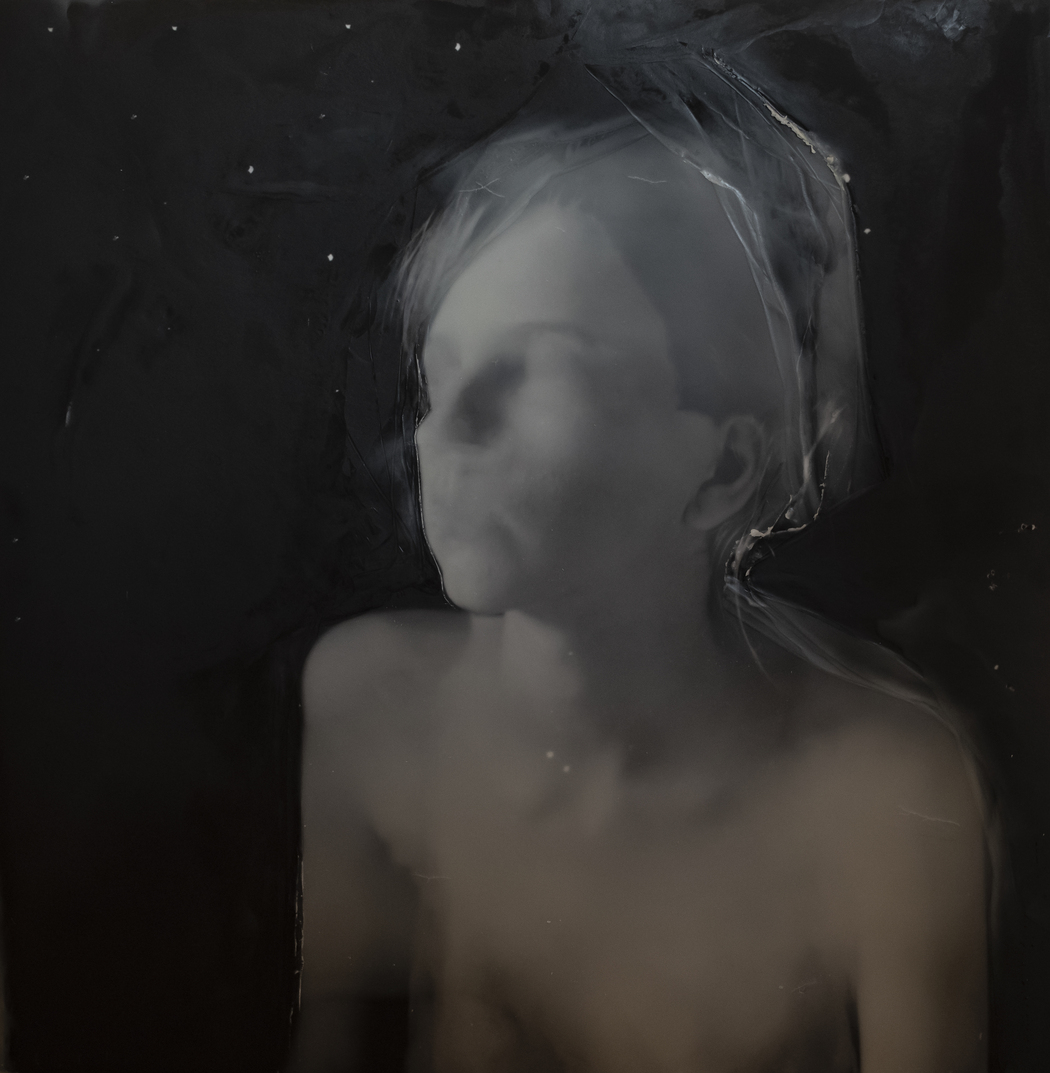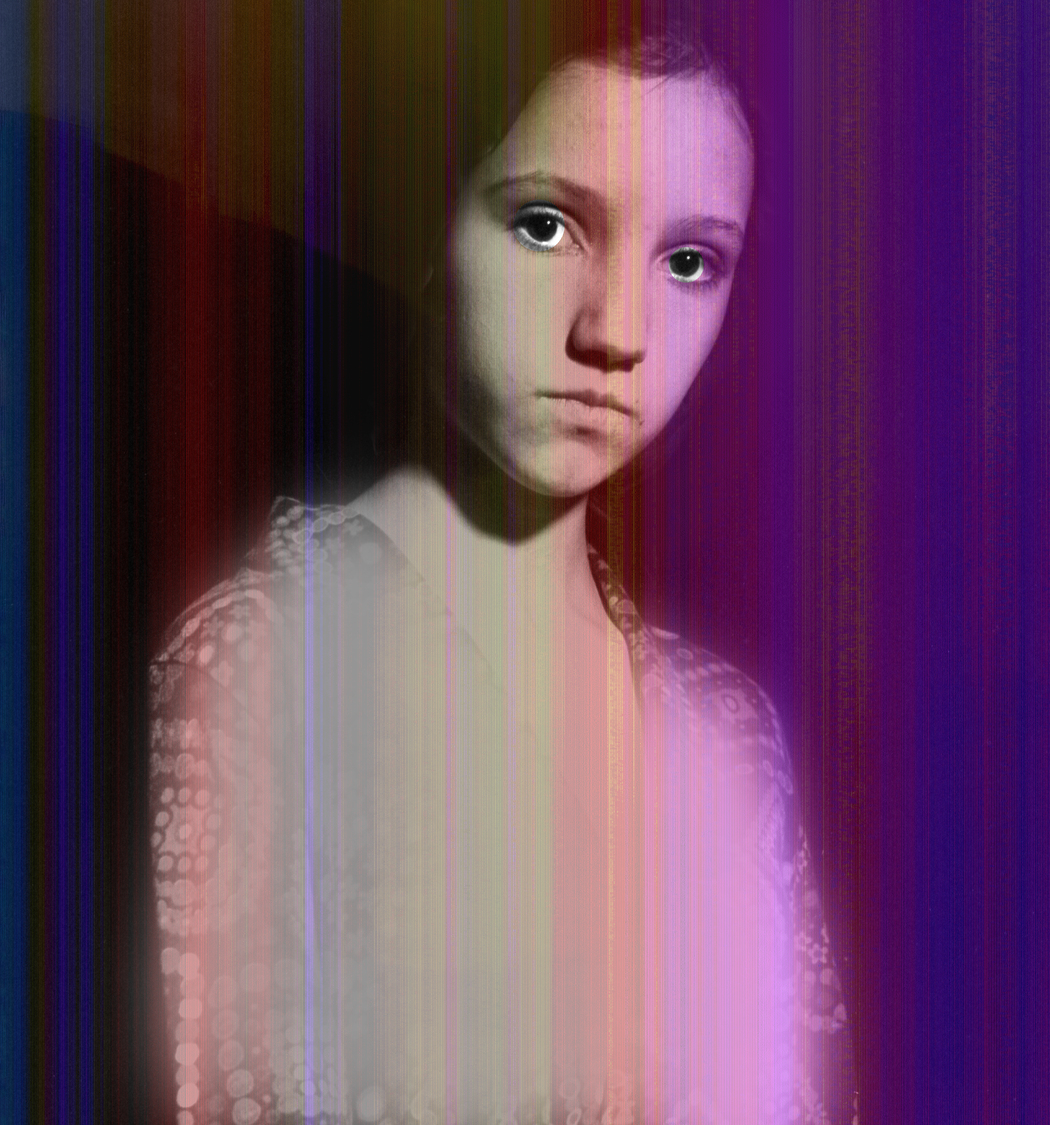Iwona Germanek
Year of birth: 1969.
Where do you live: Boszowy, Poland.
Your education: graduate of the Institute of Creative Photography in Opava, Czech Republic (bachelor), currently a master’s student at the same university.
Describe your art in three words: experiment, introspective, therapeutic.
Your discipline: photography, visual arts.
Website | Instagram
Your project “Nitki niepamiętania“ / “Threads of Unremembrance“ touches on memory and forgotten narratives. What inspired you to start working with archival materials from flea markets?
‘Threads of Nonremembrance’ is one of the earlier works that touches on the problem of memory in the family context. This theme came to me by itself. It was brought to me by life itself. One day, I found a family photo album of my grandmother in my mother’s wardrobe. This woman died shortly after my mother was born, so neither of us remembered her. But it struck me that no family member had ever mentioned her as if she did not exist. I had beautiful old photographs before me, but the memories were gone, missing. It made me wonder what role photography plays in our lives. Is it a kind of bridge between the past and the present? Is photography enough? Suddenly, I started to see a lot of pictures sold at flea markets, unwanted and forgotten. Whole photo albums filled with human stories can sometimes be bought for peanuts. So, I started buying these stories. My family photo archive was enriched by photos and albums of complete strangers. Their frozen faces looked at me calmly as if waiting for something. So I started with family photos and made collages or, as in the case of the triptych ‘Threads of Nonremembrance’, assemblages.
 Iwona Germanek | From the Series Smell | 2024
Iwona Germanek | From the Series Smell | 2024
In “Zapach“ / “Smell,” you combine contemporary photography with personal mementos. How did your experience with your mother’s dementia influence the development of this series?
My mother has been suffering from dementia for many years. The disease progresses gradually, and with each passing month, with each passing year, Małgorzata becomes an entirely different person. She loses not only her memory but also her lucidity. Everything becomes confusing for her: faces, events and time. It’s as if she’s caught in a sticky web from which there’s no way out. Over the last few years, I have often tried to imagine how a person suffering from this kind of disorder feels. I have tried to put myself in her shoes. ‘Scent’ is a story about the fragility of human nature and the helplessness of man because dementia is an irreversible process. There is no hope. Sometimes, life provides the stage for the truly grotesque. Tears of sadness mingle with tears of joy. Thus, in the series, we also see certain dissonances, paper cracks or digital manipulations that paint a distorted picture of reality. The narrative is not fluid; the leaps in time and place are characteristic of those struggling with the disease. While working on this series, I used a small analogue camera that wouldn’t catch my mother’s eye or irritate her. As a result, I got imperfect photos with flaws, very grainy, and sometimes underexposed. Their plasticity reinforces the message and conveys a feeling of unease.
You use a wide range of materials such as wax, Japanese paper, and old photographs in your works. How do these materials help convey the themes of memory and fragility?
In my work, I try to use materials that contribute to my stories outside the visual level. For example, in the ‘Pink Doesn’t Exist’ project, I used Japanese tissue paper to wrap my daughter’s portraits printed on collector’s paper in a protective gesture, but at the same time, this delicate paper, which was applied to the photograph with rice glue, was brutally peeled off in places by my own hand. Peeling off the paper was like removing a band-aid from a wound. Symbolically, it alluded to the process of therapy that Wiktoria, who was struggling with depression, was going through. The whole story is a testament to winning the battle against illness. There are also archive photos that I have taken of my child over the years. I poured wax over some of them after printing, creating a cloudy shell on the paper. Under this shell, the image of a young girl shone through. I used iron to remove this waxy layer from the photograph, trying to help it come to the surface and emerge. Wax also appears in the ‘Scent’ series, where I use a sharp tool to interfere with the surface, and the resulting scratches create an aura of unease in the viewer looking at the seemingly idyllic scene of horses grazing in a meadow. The deep scratches in the photograph shatter this image. I think the black and white work depicting the zebra in disturbing blood-red stripes, standing on three legs, evokes a similar feeling. These are all deliberate efforts to create a certain tension in the viewer.
 Iwona Germanek | From the Series Herbarium | 2021
Iwona Germanek | From the Series Herbarium | 2021
Collage and photomontage play a significant role in your artistic process. Can you talk about how these techniques enhance the emotional depth of your work?
Not unlike the artistic means I mentioned earlier, collage or photomontage also help me to achieve the intended feeling evoked by my works. When combining different types of materials, I act quite intuitively; on the other hand, I know what I want to achieve by using these or other means. However, I must admit that my choices are marked by a great deal of experimentation. I never know what the outcome of this experiment will be. It’s a kind of dialogue I have with the process itself. In constructing the ‘Pink Doesn’t Exist’ set, I reproduced my daughter’s self-portrait paintings. When I recorded one of the pictures, the camera saved the file incorrectly. I only got the coloured stripes recorded on the memory card. I thought I’d superimpose this grid on Wiktoria’s portrait. A work was created that is an icon, a star of this series. The creative process of my works can be long. It’s a path that sometimes leads me astray, but along the way I learn a lot, including about myself.
Your works often evoke a sense of the surreal and grotesque, especially in the way you alter old photographs. What draws you to these transformations, and how do they relate to your exploration of memory?
The grotesque or surrealism appeared in the ‘Scent’ series. This is inextricably linked to what we experience when faced with memory loss caused by diseases such as senile dementia. The scenes we experience while caring for someone with this condition evoke extreme emotions: helplessness, fatigue, sadness and anger, but also laughter through tears. It is a bit like taming a ghostly reality. A good example of this would be a photograph of a small child, in this case my mother, with hair rollers on her head. This work also illustrates a certain suspension of time in a patient struggling with senile dementia. My mother, who is 84 years old, can at the same time feel like a little girl who wants to be taken home, to her mother. She is waiting for her mother who died 30 years ago and there is no way to explain to her that this person is long gone.
 Iwona Germanek | From the Series Pink Dasnt Exist | 2023
Iwona Germanek | From the Series Pink Dasnt Exist | 2023
How do you feel your personal exploration of memory and family has evolved between your projects, like “Zielnik” / “Herbarium“ and “Różowy nie istnieje” / “Pink doesn’t exist“?
Working on ‘Herbarium’ took about two years; I finished it in 2020. It was a time to explore the theme of human memory, the transience and fragility of life. But it was also a time to reflect on the role of the photographer in recording mortality. The photographs, after all, show the fragility of life as it moves towards destruction. They are a remnant of life. My photographic herbarium alludes to this. Old photographs, like plants drying out in a herbarium, lose their colour, change their scent and lure us with their nostalgia. For this series, I combined archival photographs of my family with plants from our family garden. I created a series of collages and photomontages that reference dried, catalogued plants preserved for posterity. Through the photographs, each family creates its own chronicle, recorded with portraits. They are a testament to life together, and photography is a ritual of family life. This ritual prolongs memory in and of us. The photographic archive was also a source of imagery for the ‘Pink Doesn’t Exist’ series. These works deal with what I would call the memory of the soul, the memory imprinted deep within us, in our psyche. For what is depression if not a reaction to that record? We already know that we also inherit the memory of fear, of anxiety, outside the genes. Traumatic experiences leave their mark on subsequent generations. I have dealt with this issue delicately in a series of photographs entitled ‘Brooch’ from 2020, where I have tried to show the impact of family trauma stories on our reality, the here-and-now, through metaphors.
 Iwona Germanek | From the Series Pink Dasnt Exist | 2023
Iwona Germanek | From the Series Pink Dasnt Exist | 2023
Your project statement mentions the fear of losing one’s memories. How do you channel this fear into creative energy, and how does it shape the narratives you create?
In my latest series, entitled ‘Scent’, I touch on the area of memory as one of the functions of the human mind. This function allows us to store and reproduce information. It is through memory that we know who we are. What happens to us when our brain is denied access to its resources? How do we function in the world when we lose control of ourselves, of our own lives? How do we function in the world when we lose control of ourselves, of our own lives, when illness takes away what we have worked for over many years? In ‘Scent’ we find traces of the anxiety of this experience in the form of disintegrating faces. Their contours are blurred, details are degraded. I degraded my own face in a similar way. It’s a kind of decay when you’re alive and in despair.

Leave a Reply